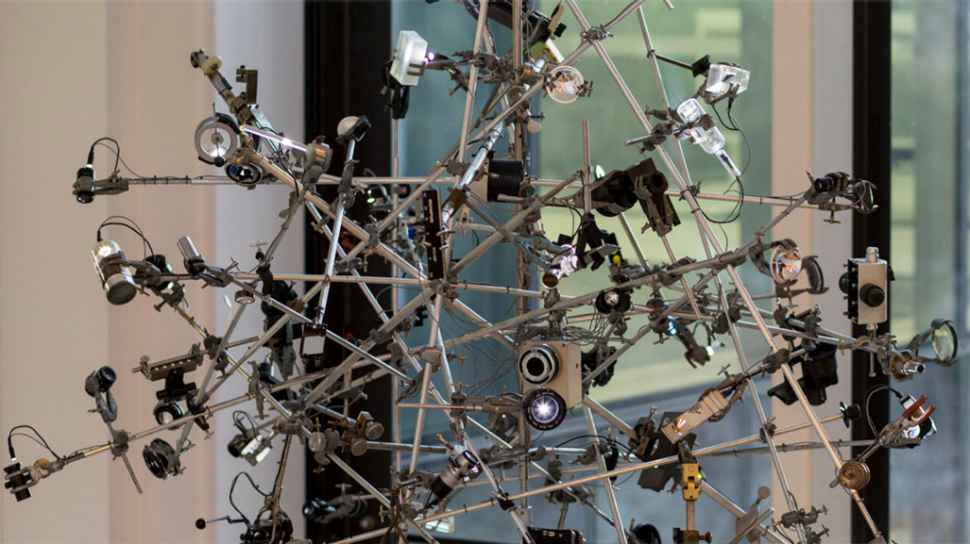Traditionally trained in glass Deb Jones’ solo and collaborative art practice upholds the philosophy that form should follow function. Her works appear raw in nature and adhere to the aesthetic that ‘less is more’. With a restricted colour palette the focus remains on the control of her medium and use of light.
Chandelier grew from Jones’ attraction to the lenses and translucent and mirrored surfaces extracted from the microscopes and ancillary equipment. Including eye-pieces, prisms, vacuum tubes, filters and her own hand cut glass, the various components are reconfigured using bosshead and retort clamps.
Shadows cast by the slowly spinning work and the accompanying soundtrack composed by Gibbins – combining ambient and upbeat sequences sampled from the Vanox and the voices of collaborators Jones and Truman – bring a mesmerizing quality to the work.
The Microscope Project
In 2012 Flinders University decommissioned a suite of microscopes and ancillary tools and equipment from the School of Medicine. Making way for new models at the cutting edge of technology, the older machines – beautifully designed, reliable, long-serving and worth a hefty sum in their heyday – now faced the bleak and unceremonious prospect of the scrapheap. The Microscope Project was conceived in response: as an opportunity to reinterpret the instruments and their peripheral parts through the lens of creative practice.
The brainchild of Ian Gibbins and Catherine Truman, the project grew out of the artist-in- residence initiative set up by Gibbins as Professor of Anatomy and Histology at Flinders in 2009, which saw Truman working alongside him in the Autonomic Neurotransmission Laboratory for three years. The team expanded to include artists Nicholas Folland, Deb Jones and Angela Valamanesh and writer Melinda Rackham, each of whom have previously demonstrated an interest in the art-science nexus.
Flinders University Museum of Art embraced The Microscope Project as an idea in 2012 and oversaw its development throughout 2013-2014. Pivotal to this process was the establishment of a shared studio where the microscopes could be stripped back and their components laid out. In this lab-like setting, artists worked together – and apart – negotiating the project’s outcomes in ways that bring to the public a conversation around the complex ways that we see, perceive and construct the world in which we live. Chandelier provides a glimpse of the kind of work to emerge.
The Microscope Project was funded by the Government of South Australia through Arts SA (New Exhibitions Fund) and by Anatomy and Histology, Flinders University.
Flinders University Museum of Art
Flinders University I Sturt Road I Bedford Park SA 5042
Located ground floor Social Sciences North building, Humanities Road adjacent carpark 5
Telephone | +61 (08) 8201 2695
Email | museum@flinders.edu.au
Monday to Friday | 10am - 5pm or by appointment
Thursdays | Until 7pm
Closed weekends and public holidays
FREE ENTRY
Flinders University Museum of Art is wheelchair accessible, please contact us for further information.



